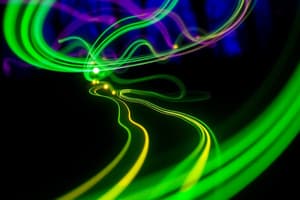Podcast
Questions and Answers
What is perception?
What is perception?
The set of processes by which we recognize, organize, and make sense of the sensations we receive from environmental stimuli.
What is the dorsal pathway responsible for?
What is the dorsal pathway responsible for?
- Emotional responses
- Recognizing objects
- Processing location and motion information (correct)
- Processing color and shape
What is the ventral pathway also known as?
What is the ventral pathway also known as?
- How pathway
- Where pathway
- What pathway (correct)
- Processing pathway
The what–where hypothesis suggests that the two pathways refer to what things are and where they are.
The what–where hypothesis suggests that the two pathways refer to what things are and where they are.
What stimulates sensory adaptation?
What stimulates sensory adaptation?
Light is electromagnetic radiation that can be described in terms of __________.
Light is electromagnetic radiation that can be described in terms of __________.
What does bottom-up theory describe in perception?
What does bottom-up theory describe in perception?
What are the four main bottom-up theories of form and pattern perception?
What are the four main bottom-up theories of form and pattern perception?
What are rods and cones?
What are rods and cones?
The __________ is the small, thin region of the retina where vision is most acute.
The __________ is the small, thin region of the retina where vision is most acute.
Flashcards are hidden until you start studying
Study Notes
Perception
- Perception is the process of recognizing, organizing, and understanding sensations from the environment.
- James Gibson introduced the concepts of distal objects, informational medium, proximal stimulation, and perceptual objects to study perception
- Perception involves sensory adaptation where receptors stop firing when they receive constant stimulation.
- Sensory receptors create a mental representation of a stimulus.
Visual Pathways
- The dorsal pathway or "where" pathway processes location and motion information
- The ventral pathway or "what" pathway primarily processes color, shape, and identity of visual stimuli
- The what-where hypothesis is the idea that the two visual pathways handle object identity and location, respectively
- Most research in this area was done with monkeys
- An alternative to the what-where hypothesis is the what-how hypothesis
- The what-how hypothesis suggests the two visual pathways are responsible for understanding object identity and their function
The Eye
- The eye receives electromagnetic radiation in the form of light.
- Light passes through the cornea, which protects the eye, followed by the pupil, which is the opening in the iris.
- The light continues through the lens and the vitreous humor, a gel-like fluid making up most of the eye.
- The electromagnetic light energy is converted into neural impulses in the retina
- Visual acuity is greatest in the fovea, a small region on the retina.
- The retina contains photoreceptors, rods and cones, responsible for converting light energy.
- Rods are long and thin, while cones are shorter and thicker.
Bottom-Up Theories of Perception
- Bottom-up theories emphasize the role of sensory stimuli in perception
- Direct perception, also known as ecological perception, states that sensory information and context are sufficient for perception
- Template theories suggest that patterns are recognized by comparing them to highly detailed models stored in memory
- Template matching theories are chunk-based theories, suggesting expertise involves acquiring knowledge chunks in long-term memory
- Feature-matching theories propose that we recognize patterns by matching their features to features stored in memory, rather than matching whole patterns.
Studying That Suits You
Use AI to generate personalized quizzes and flashcards to suit your learning preferences.




